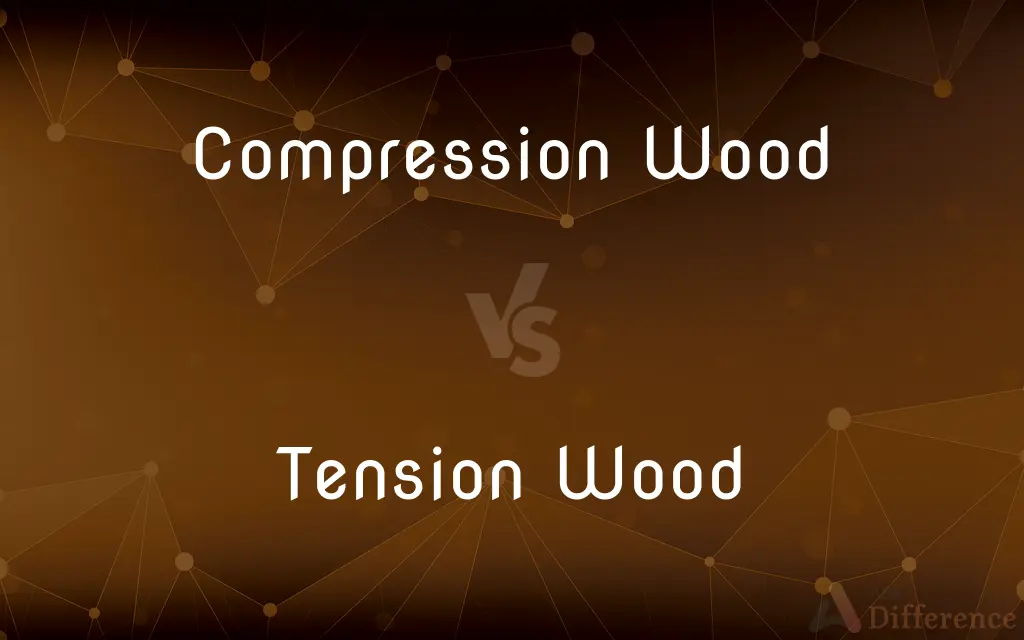Compression Wood vs. Tension Wood — What's the Difference?
By Urooj Arif & Fiza Rafique — Published on March 6, 2024
Compression wood forms in conifers under mechanical stress, leading to denser, darker wood, while tension wood occurs in hardwoods, characterized by increased cellulose for upward growth.

Difference Between Compression Wood and Tension Wood
Table of Contents
ADVERTISEMENT
Key Differences
Compression wood develops on the lower side of branches and leaning stems in gymnosperms (conifers) as a response to gravitational forces. This type of wood is characterized by its high density, darker color, and increased mechanical strength, which help the tree maintain or regain its vertical orientation. Tension wood, on the other hand, forms primarily in angiosperms (hardwoods) on the upper side of branches and leaning stems. It features a higher proportion of cellulose and a special kind of cell, known as gelatinous fibers, which contribute to its ability to generate a pulling force, aiding in upward growth and structural support.
The formation of compression wood results in uneven growth and physical properties that can be considered defects in lumber, such as reduced dimensional stability and increased brittleness. Tension wood, while also leading to growth irregularities, often results in wood that has peculiarities like an increased tendency to shrink and distort during drying. Both types of reaction wood significantly impact the timber industry, affecting the processing and end-use of wood products.
Microscopically, compression wood cells are more rounded with thicker cell walls and a reduced lumen (the hollow part of the cell), which contributes to its higher density. In tension wood, the presence of gelatinous fibers with a thickened, cellulose-rich inner layer (the G-layer) distinguishes it. These fibers lack the normal lignification seen in regular wood cells, which gives tension wood its unique properties.
Both compression and tension wood are natural adaptations to environmental stresses, enabling trees to cope with mechanical forces such as wind, snow load, and gravitational pull. Understanding the differences between these two types of wood is crucial for foresters, arborists, and wood technologists in managing forests, harvesting timber, and utilizing wood in various applications.
Comparison Chart
Occurrence
In conifers (gymnosperms)
In hardwoods (angiosperms)
ADVERTISEMENT
Location in Tree
Lower side of branches/stems
Upper side of branches/stems
Cell Characteristics
Rounded cells, thick cell walls, small lumen
Gelatinous fibers, thick G-layer, less lignified
Physical Properties
High density, dark color, increased brittleness
Increased cellulose, prone to shrinkage and distortion
Response to Stress
Develops to counteract compressive forces
Develops to exert tensile forces for upward growth
Impact on Wood Quality
Reduced dimensional stability, considered a defect
Can cause irregularities, affects drying and machining
Compare with Definitions
Compression Wood
Forms on the underside of branches and stems, aiding in the tree's upright growth.
Compression wood formation was evident on the lower side of the sloped fir tree.
Tension Wood
Contains gelatinous fibers that are rich in cellulose and lack typical lignification, giving it unique properties.
The tension wood in the beech sample was distinguished by its gelatinous fibers.
Compression Wood
Wood that is darker and harder due to its altered cell structure and composition.
The darker areas of the log were identified as compression wood.
Tension Wood
Can be challenging to identify and manage in wood products due to its irregular behavior.
Woodworkers often encounter difficulties when working with tension wood due to its unpredictable nature.
Compression Wood
Features cells with thick walls and a reduced lumen, impacting its mechanical properties.
Microscopic examination revealed the typical rounded cells of compression wood.
Tension Wood
Reaction wood in hardwoods that forms on the upper side of branches and stems, facilitating upward growth.
The leaning oak had developed tension wood to counteract gravity.
Compression Wood
A type of reaction wood in conifers, formed in response to mechanical stress, characterized by its high density and strength.
The pine tree developed compression wood on its leaning side to stabilize itself.
Tension Wood
Prone to shrinkage and distortion, especially during the drying process.
The harvested ash wood with tension wood exhibited considerable distortion upon drying.
Compression Wood
Known to cause issues in lumber, such as warping and reduced quality.
The presence of compression wood in the lumber led to significant challenges during milling.
Tension Wood
Aids the tree in pulling itself upright through tensile strength.
Tension wood played a crucial role in the tree's ability to grow vertically despite its initial lean.
Common Curiosities
How can you identify compression and tension wood?
Compression wood is denser, darker, and typically found on the lower side of conifer branches/stems, while tension wood contains gelatinous fibers, is lighter, and found on the upper side of hardwood branches/stems.
Can both compression and tension wood be found in the same tree?
Generally, compression wood is found in conifers and tension wood in hardwoods, so they typically occur in different types of trees.
How do compression and tension wood affect the timber industry?
They can lead to reduced wood quality and processing challenges, such as warping, brittleness, or distortion, impacting the usability of wood in construction and manufacturing.
What causes the formation of compression and tension wood?
Both are formed in response to mechanical stresses, such as gravity, wind, or physical damage, as the tree seeks to maintain or regain vertical growth.
What are the challenges in working with compression and tension wood?
Woodworkers and manufacturers must contend with issues like warping, cracking, and irregularities during drying and machining, requiring specialized treatment and handling.
Can reaction wood be prevented?
While difficult to prevent in natural settings, forest management practices can minimize the development of reaction wood through proper spacing, pruning, and support.
How do foresters manage trees with reaction wood?
Foresters may employ selective harvesting, pruning, and staking to reduce the incidence of reaction wood and improve overall timber quality.
How do trees benefit from developing reaction wood?
Reaction wood helps trees maintain structural integrity and upright growth in response to mechanical stresses, ensuring their survival and continued growth.
Do compression and tension wood have any uses?
Despite their challenges, some industries may utilize these woods in specialized applications where their unique properties, such as increased density or tensile strength, are beneficial.
Are there any benefits to compression or tension wood?
While often seen as defects in lumber, these adaptations are crucial for the survival of trees, enabling them to withstand environmental stresses.
How does reaction wood affect the paper industry?
The altered fiber properties of reaction wood can impact paper quality, requiring adjustments in pulping and papermaking processes to manage strength, brightness, and other characteristics.
Is reaction wood more common in certain environments?
Trees in windy, sloped, or unstable environments are more likely to develop reaction wood as they adapt to mechanical stresses.
Can reaction wood be used in energy production?
While not ideal for lumber, reaction wood may be used as biomass for energy production, though its higher density or cellulose content can affect combustion properties.
Does reaction wood affect all tree species equally?
The propensity to develop reaction wood and its characteristics can vary widely among species, affecting how trees are managed and used.
Are there any environmental implications of reaction wood?
The development of reaction wood reflects a tree's adaptation to its environment, highlighting the importance of understanding and preserving natural habitats for forest health and diversity.
Share Your Discovery

Previous Comparison
Piaget Theory vs. Vygotsky Theory
Next Comparison
2 Percent Milk vs. Whole MilkAuthor Spotlight
Written by
Urooj ArifUrooj is a skilled content writer at Ask Difference, known for her exceptional ability to simplify complex topics into engaging and informative content. With a passion for research and a flair for clear, concise writing, she consistently delivers articles that resonate with our diverse audience.
Co-written by
Fiza RafiqueFiza Rafique is a skilled content writer at AskDifference.com, where she meticulously refines and enhances written pieces. Drawing from her vast editorial expertise, Fiza ensures clarity, accuracy, and precision in every article. Passionate about language, she continually seeks to elevate the quality of content for readers worldwide.
















































